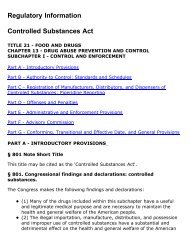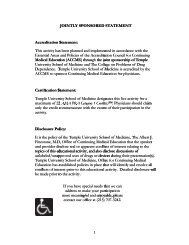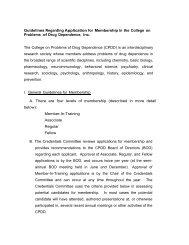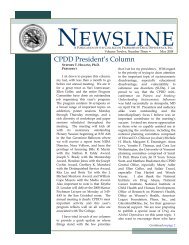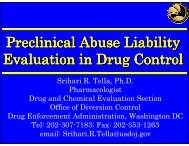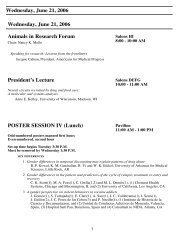CPDD 72nd Annual Meeting • Scottsdale, Arizona - The College on ...
CPDD 72nd Annual Meeting • Scottsdale, Arizona - The College on ...
CPDD 72nd Annual Meeting • Scottsdale, Arizona - The College on ...
You also want an ePaper? Increase the reach of your titles
YUMPU automatically turns print PDFs into web optimized ePapers that Google loves.
125<br />
NATIONAL MONITORING OF ADOLESCENT PRESCRIPTION<br />
STIMULANTS STUDY (N-MAPSS): STIMULANT MEDICATION<br />
USE AMONG 10 TO 18 YEAR OLDS.<br />
Linda B Cottler, A Ben Abdallah, S E Bradford, C L Striley; Psychiatry,<br />
Washingt<strong>on</strong> University School of Medicine, St. Louis, MO<br />
Aims: N-MAPSS is an innovative nati<strong>on</strong>al study that estimates the prevalence of<br />
use, misuse, abuse and diversi<strong>on</strong> of prescripti<strong>on</strong> stimulants am<strong>on</strong>g youth 10 to<br />
18 years old.<br />
Methods: An entertainment venue intercept method was used to collect data<br />
from teens in ten cities: Bost<strong>on</strong>, Cincinnati, Denver, Houst<strong>on</strong>, Los Angeles, New<br />
York City, Philadelphia, Seattle, St. Louis and Tampa. Youth completed an<br />
an<strong>on</strong>ymous two-part survey covering demographics, ADD/ADHD diagnosis,<br />
pill identificati<strong>on</strong>, risk behaviors, stimulant use, misuse and diversi<strong>on</strong>, as well as<br />
use of other prescripti<strong>on</strong> drugs, alcohol and illicit drugs. <str<strong>on</strong>g>The</str<strong>on</strong>g> survey assessed adolescent<br />
experiences with using and reas<strong>on</strong>s for taking prescripti<strong>on</strong> stimulants,<br />
including whether or not they had ever been told by a doctor or parent to do so.<br />
Results: Overall, 19% of youth reported stimulant use in their lifetime (any use,<br />
not limited to misuse/abuse); of which half (~9%) reported any use in the last 30<br />
days. Use increased with age and diagnosis of ADHD. Half of the past 30 day<br />
users misused their stimulants. Am<strong>on</strong>g the youth with ADHD, those who misused<br />
stimulants were more likely than those who did not misuse to report current<br />
smoking, an alcohol binge in the last 30 days, and illegal drug use.<br />
C<strong>on</strong>clusi<strong>on</strong>s: This study provides important informati<strong>on</strong> to address sociological,<br />
demographic and behavioral factors associated with medical and n<strong>on</strong>-medical<br />
use of prescripti<strong>on</strong> stimulants which may aid in detecting misuse of stimulants<br />
in the future.<br />
Financial Support: N-MAPSS is implemented by Washingt<strong>on</strong> University in St.<br />
Louis under c<strong>on</strong>tract from Pinney Associates, Inc., with funding provided by<br />
Shire Pharmaceuticals.<br />
127<br />
PREDICTORS OF TREATMENT COMPLETION AMONG<br />
OFFENDERS ENROLLED IN A COMMUNITY-BASED<br />
OUTPATIENT PROGRAM.<br />
D<strong>on</strong>na M Coviello 1 , D A Zanis 1,2 , S A Wesnoski 1 , N R Palman 1 ,AErez 1 ;<br />
1 University of Pennsylvania, Philadelphia, PA, 2 Temple University,<br />
Philadelphia, PA<br />
Aims: Despite the well established link between crime and substance abuse,<br />
many offenders do not receive treatment, or <strong>on</strong>ce enrolled, do not complete<br />
treatment. Research has c<strong>on</strong>sistently dem<strong>on</strong>strated that substance abusers who<br />
stay in treatment l<strong>on</strong>ger have less subsequent drug use and commit fewer crimes.<br />
<str<strong>on</strong>g>The</str<strong>on</strong>g> aim of the present study was to assess the predictors of treatment completi<strong>on</strong><br />
am<strong>on</strong>g a sample of offenders attending a community-based drug-free outpatient<br />
program.<br />
Methods: Currently, the sample c<strong>on</strong>sists of 107 offenders enrolled in a study<br />
assessing the effectiveness of a six m<strong>on</strong>th treatment protocol that integrates drug<br />
and employment counseling. <str<strong>on</strong>g>The</str<strong>on</strong>g> offenders are under various levels of supervisi<strong>on</strong><br />
including county and state probati<strong>on</strong>/parole, a treatment court and an alternative<br />
dispositi<strong>on</strong> program. Research assessments are collected at baseline, every<br />
other week during the six m<strong>on</strong>th treatment phase and at six, 12 and 18 m<strong>on</strong>ths<br />
post-treatment entry. Urine drug screens are collected weekly.<br />
Results: <str<strong>on</strong>g>The</str<strong>on</strong>g> sample is predominately male (91%) and the majority are African<br />
American (62%). <str<strong>on</strong>g>The</str<strong>on</strong>g> average age of subjects is 34 years and the average amount<br />
of time participants spent incarcerated is nearly 3 1⁄ 2 years. One-third are dependent<br />
<strong>on</strong> cannabis (33%), <strong>on</strong>e-third are alcohol dependent (32%), 30% are<br />
dependent <strong>on</strong> cocaine and <strong>on</strong>e-fifth (20%) are opioid dependent. Preliminary<br />
findings from logistic regressi<strong>on</strong> analyses indicate that those who are mandated<br />
to treatment, such as treatment court or the alternative dispositi<strong>on</strong> program, are<br />
six times more likely to complete treatment (OR=6.1,CI=1.2-32.1,p=.033),<br />
whereas those who are opioid dependent are 3.7 times less likely to complete the<br />
six m<strong>on</strong>th treatment protocol(OR=3.7,CI=1.1-12.6,p=.035).<br />
C<strong>on</strong>clusi<strong>on</strong>s: Requiring offenders to attend treatment may be an effective way<br />
to increase treatment compliance, and hence reduce drug use and recidivism.<br />
However, offenders with an opioid dependence diagnosis may require medicati<strong>on</strong><br />
assisted therapy to experience positive treatment outcomes.<br />
Financial Support: Supported by NIDA grant R01DA019600.<br />
<str<strong>on</strong>g>CPDD</str<strong>on</strong>g> <str<strong>on</strong>g>72nd</str<strong>on</strong>g> <str<strong>on</strong>g>Annual</str<strong>on</strong>g> <str<strong>on</strong>g>Meeting</str<strong>on</strong>g> <str<strong>on</strong>g>•</str<strong>on</strong>g> <str<strong>on</strong>g>Scottsdale</str<strong>on</strong>g>, <str<strong>on</strong>g>Ariz<strong>on</strong>a</str<strong>on</strong>g><br />
32<br />
126<br />
FRENCH SURVEY ABOUT STUDENTS’ HEALTH IN 5<br />
UNIVERSITY HEALTH AND PREVENTION CENTERS.<br />
Pascal Courty 1,2 , G Illes 2 , C Auclair 3 , A Perreve 2 , M Argillet 4 , B Poizat 5 ,M<br />
Zorman 6 , S Bl<strong>on</strong>del 7 , L Gerbaud 2,3 ; 1 CMP B, CSST SATIS, Clerm<strong>on</strong>t Ferrand<br />
cedex 1, France, 2 University Health and Preventi<strong>on</strong> Center, CLERMONT<br />
FERRAND, France, 3 Department of Epidemiology and Public Health,<br />
University Hospital Clerm<strong>on</strong>t Ferrand, CLERMONT FERRAND, France,<br />
4 University Health and Preventi<strong>on</strong> Center, SAVOIE, France, 5 University Health<br />
and Preventi<strong>on</strong> Center, Saint Etienne, France, 6 University Health and<br />
Preventi<strong>on</strong> Center, Grenoble, France, 7 University Health and Preventi<strong>on</strong><br />
Center, Ly<strong>on</strong>, France<br />
Aims: To describe students’ health and quality of life, evaluate psychoactive<br />
drugs c<strong>on</strong>sumpti<strong>on</strong>s and motivati<strong>on</strong>s to come to the University Health and<br />
Preventi<strong>on</strong> Centers (UHPC) some of them being as dispensaries too<br />
Methods: 1572 students were included during 5 weeks in 5 different sites<br />
(Clerm<strong>on</strong>t Ferrand, Savoie, St Etienne, Ly<strong>on</strong>, Grenoble). Sociodemographic<br />
data, SF 36(short versi<strong>on</strong>), EPICES Score (French deprivati<strong>on</strong> index) alcohol,<br />
tobacco and cannabis use as well as motives for c<strong>on</strong>sulting were analyzed in each<br />
center whether they are <strong>on</strong>ly UHPC or dispensaries too. Logistic regressi<strong>on</strong>s were<br />
processed to determine specific profiles of students<br />
Results: Significant differences (p



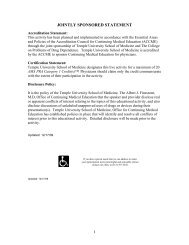
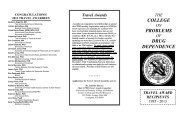
![2013SYMP AND WORKSHOP LIST[web]](https://img.yumpu.com/35325424/1/190x245/2013symp-and-workshop-listweb.jpg?quality=85)
